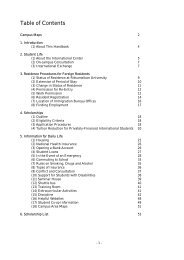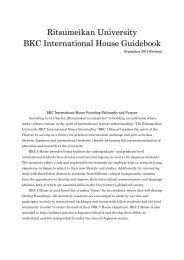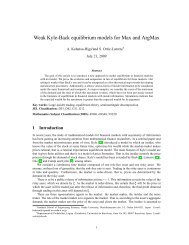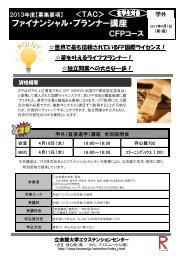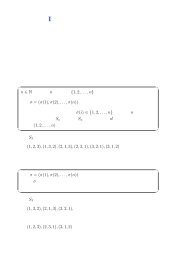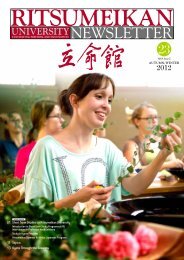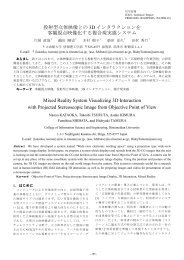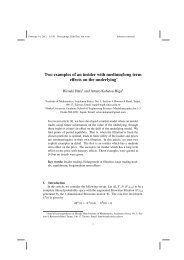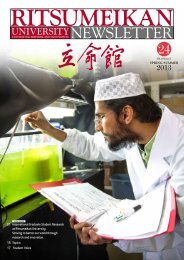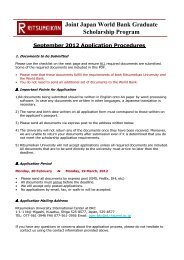Powering the Future - 立命館大学
Powering the Future - 立命館大学
Powering the Future - 立命館大学
You also want an ePaper? Increase the reach of your titles
YUMPU automatically turns print PDFs into web optimized ePapers that Google loves.
Research/Development Areas<br />
Physicochemical processing method for<br />
safe tap water<br />
Research/Development Areas<br />
Water treatment and lake management<br />
Professor / Naoyuki KAMIKO<br />
Running water is essential in our lives as we are use it for cooking,<br />
doing <strong>the</strong> laundry, bathing, and for drinking.<br />
However, it has recently been discovered that a disease organism<br />
called cryptosporidium could be threatening <strong>the</strong> safety of<br />
water. Cryptosporidium gets discharged from infected warmblooded<br />
animals to survive and propagate in ano<strong>the</strong>r warmblooded<br />
animal within a shell that is immune to disinfectant like<br />
chlorine.<br />
Something that cryptosporidium is not immune to though is<br />
water being irradiated with ultraviolet light. However, if <strong>the</strong><br />
amount of ultraviolet light is too small <strong>the</strong> disinfection process<br />
can be insufficient, but if too much is used <strong>the</strong> equipment or<br />
operation can be uneconomical. We are carrying out various inspections<br />
for use in <strong>the</strong> appropriate design and operation of ultraviolet<br />
disinfection.<br />
Professor / Jun NAKAJIMA<br />
We aim to contribute to <strong>the</strong> welfare of human society by promoting<br />
recognition of aquatic pollution, clarification of its cause<br />
and mechanism, and basic/applied research on technology for<br />
purification and mitigation.<br />
●Lake Biwa group: This group is researching <strong>the</strong> behavior of<br />
phosphorus that flows into <strong>the</strong> lake from <strong>the</strong> drainage basin<br />
by measuring <strong>the</strong> phosphorus, which <strong>the</strong>n enables biological<br />
utilization that causes eutrophication of <strong>the</strong> lake. They are<br />
also involved in a collaborative investigation with Shiga Prefecture<br />
and research on Lake Biwa and its lagoons.<br />
●Arsenic group: This group is clarifying <strong>the</strong> mechanism of arsenic<br />
polluting groundwater and researching a sustainable<br />
water supply system in cooperation with a university and<br />
NGO in Bangladesh. They are also measuring <strong>the</strong> amounts of<br />
coli phage etc in water for use as a hygiene index. They also<br />
carry out field investigations.<br />
●Water reclamation group: This group is researching advanced<br />
processing technology<br />
for wastewater reclamation<br />
and reuse. Membrane<br />
bioreactor is investigated<br />
for decrease<br />
of its membrane fouling<br />
risk.<br />
College of S cience and Engineering<br />
■A Petri dish containing microorganisms<br />
is sterilized using<br />
an ultraviolet lamp.<br />
■What technology would be useful to<br />
children who drink groundwater<br />
polluted by arsenic?<br />
Research/Development Areas<br />
Development and application of<br />
environmentally-friendly construction<br />
material and its compounding technique<br />
Professor / Takahisa OKAMOTO<br />
We are conducting research on <strong>the</strong> following topics:<br />
(1) Creation of a new sounding body made with a cement-based hardened<br />
body, which is in harmony with environmental education<br />
- Development of manufacturing technology for new string and wind<br />
instruments using a high-performance cement-based hardened body.<br />
(An alpenhorn and pipe organ made of concrete won <strong>the</strong> prizes at <strong>the</strong><br />
2008 and 2009 handcrafted instrument contest in Japan.)<br />
- Quantitative evaluation of <strong>the</strong> healing effect of <strong>the</strong> new sounding body on<br />
humans: evaluation of <strong>the</strong> healing effect of <strong>the</strong> music generated using a<br />
cement-based hardened body instrument through organoleptic<br />
assessment (holding concerts etc.).<br />
(2) Promoting <strong>the</strong> reproduction of folk houses, taking into consideration <strong>the</strong><br />
regional characteristics, comfort and earthquake protection.<br />
- Investigation of <strong>the</strong> historical and cultural value of folk houses constructed<br />
using traditional Japanese construction materials and technology,<br />
evaluation and analysis of natural energy utilization by folk houses.<br />
(3) Resolving environmental problems using multi-hole cement-based<br />
hardened bodies (porous concrete).<br />
- Plantimal and water-purification utilizing porous concrete: suggestion of a<br />
plantimal construction method that utilizes natural power.<br />
(4) Development of concrete for early open type pavement<br />
- Developing early open type concrete pavement technology where large<br />
parts of <strong>the</strong> material can be covered<br />
with domestic limestone, and estimating<br />
<strong>the</strong>ir life cycle, cost, and life cycle<br />
assessment.<br />
Research/Development Areas<br />
Landscape planning for creating<br />
sustainable regions<br />
Associate Professor / Yasuyuki SASATANI<br />
We are carrying out fieldwork in cooperation with <strong>the</strong> inhabitants,<br />
companies, and elementary school students etc around<br />
our university in rediscovering <strong>the</strong> attractive resources that are<br />
inherent to <strong>the</strong> region and proposing <strong>the</strong> creation of environmental<br />
towns and landscapes etc. As one method we are trying<br />
to make presentations to <strong>the</strong> general public so that <strong>the</strong>y can<br />
comprehend <strong>the</strong> future image of <strong>the</strong>ir region easier by combining<br />
and registering photos, videos, animation and audio etc on<br />
computerized maps and creating <strong>the</strong> content mixed with media.<br />
More concretely we are reproducing <strong>the</strong> past landscape of<br />
<strong>the</strong> town using old maps or photos and <strong>the</strong> current landscape<br />
with three-dimensional graphics and displaying <strong>the</strong> landscape<br />
of a sustainable society for <strong>the</strong> future in three dimensions using<br />
those characteristics. We are also proposing circulative composite<br />
space utilization as a supply center of food and energy,<br />
conservation of national land such as through recharging water<br />
sources, conservation of life’s diversity, <strong>the</strong> economic base of<br />
regions, and fields for recreational<br />
activities in <strong>the</strong><br />
countryside and mountains<br />
near towns that have various<br />
values.<br />
■The alpenhorn made of concrete being<br />
fabricated. The motto of our daily activity in <strong>the</strong><br />
laboratory is “bright, happy and strong”.<br />
■Registration of a future images<br />
drawn by elementary school<br />
students is supported.<br />
Ritsumeikan University<br />
<strong>Powering</strong> <strong>the</strong> <strong>Future</strong><br />
30



